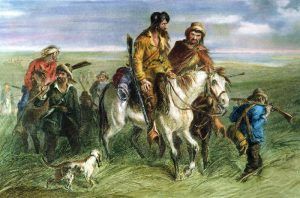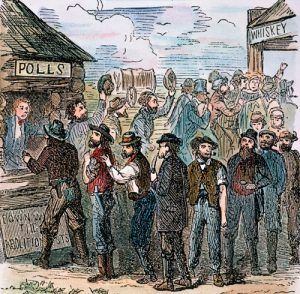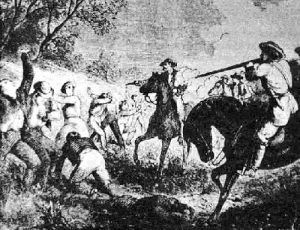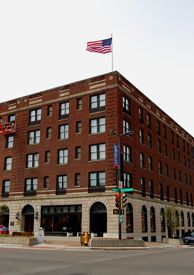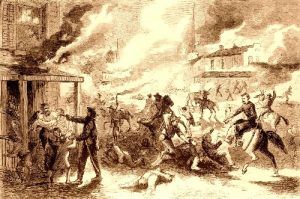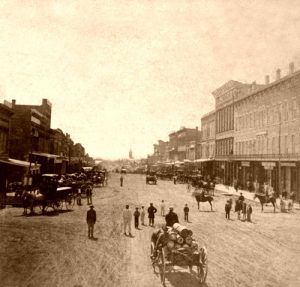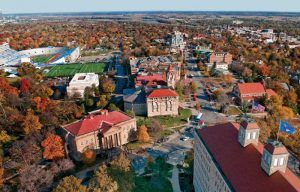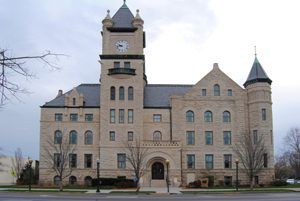
Lawrence, Kansas today by Ian Ballinger, Wikimedia
Lawrence, Kansas, the county seat of Douglas County, was established after the Kansas-Nebraska Act was passed in 1854, creating Kansas Territory. It soon became the de facto capital of the Free State Movement as the territory was immersed in the “Bleeding Kansas” period. Today, it is a college town — home to both the University of Kansas and Haskell Indian Nations University.
Before Lawrence existed, these rolling plains were home to Native Americans for thousands of years. The most prominent indigenous nations were the Kanza, Osage, Wichita, Kiowa, Kiowa-Apache, Comanche, Pawnee, Cheyenne, and Arapaho.
But, as the new America began to push West in the 1820s, traders and explorers started to travel the western trails of what would become known as the Oregon and Santa Fe Trails. The Indians had long used these paths between camping and hunting sites. Explorers, trappers, traders, soldiers, and settlers began to follow the Indian paths to the West with earnestness. The settlement of Lawrence, which would not be formed for another 30 years, was located between the Oregon and Santa Fe Trails.
Kansas Territory was opened to settlement on May 30, 1854, by the Kansas-Nebraska Act. According to “popular sovereignty,” settlers could decide whether to admit their territory as a slave or a free state. Soon, New England abolitionists began organizing emigrant aid societies to encourage like-minded citizens to settle in the new territory. On August 1, 1854, Twenty-nine northern emigrants, mainly from Massachusetts and Vermont, were the first to arrive in Lawrence, Kansas, named for Amos A. Lawrence, a promoter of the Emigrant Aid Society. In September, a second party of 200 men, women, and children arrived. Lawrence is one of the few cities in Kansas founded purely for political reasons.
On October 16, 1854, the first anti-slavery newspaper was established in Lawrence to voice the sentiments of the New England Emigrant Society. The newspaper, called the Kansas Pioneer, enraged the pro-slavery supporters. The name of the paper shortly changed to the Kansas Tribune.
The first school taught in Lawrence was commenced on January 16, 1855, by Edward P. Fitch from Hopkinton, Massachusetts. Located in the back office of the Emigrant Aid Building began with about 20 students.
On December 1, 1855, a small army of Missourians, acting under the command of Sheriff Samuel J. Jones, laid siege to Lawrence in the opening stages of what would later become known as “The Wakarusa War.” However, the new governor, Wilson Shannon, kept the pro-slavery men from attacking Lawrence.
But, later, when a young man, who had come to the aid of the Free-Staters, rode off to his home about six miles west of Lawrence, he was met by a group of pro-slavery men from Lecompton. Though the man never even drew his weapon, he was shot in cold blood by the pro-slavery faction. His body was returned to Lawrence, where the entire citizenry followed it to its burial, in the presence of his young wife and children, in Pioneer Cemetery. More than any other, this event hardened the Free-Staters to realize that they had come not simply for an election to determine whether Kansas would be free or slave but to fight a war over the issue.
On May 21, 1856, a motley group of about 700 armed pro-slavery enthusiasts raided Lawrence, the stronghold of the abolitionist movement. They burned the Free State Hotel (now the Eldridge Hotel), smashed the presses of two Lawrence newspapers, ransacked homes, and stores, and killed one man. The event became known as the “Sacking of Lawrence.”
Lawrence also acted as an essential stop on the Underground Railroad, safely helping escaped slaves reach freedom. Anti-slavery Jayhawkers from Kansas frequently clashed with pro-slavery Bushwhackers from the neighboring slave state of Missouri. The Missouri/Kansas border war grew in 1861 after the war broke out, and Kansas chose to become a free state. Lawrence became the continuing scene of several bloody encounters, and the state would become known as Bleeding Kansas.
The worst occurred in 1863 when William Quantrill assembled a group of 400 men in Missouri and rode into Lawrence, a town long hated by Quantrill and his men. Home of the demagogic anti-slavery Senator Jim Lane, it was also a stronghold of the Red Legs, Union guerrillas who had sacked much of western Missouri. An attack on this citadel of abolition would bring revenge for any wrongs that the Southerners had suffered, real or imagined.
Early on the morning of August 21, 1863, Quantrill’s Raiders descended on the still-sleeping town of Lawrence. In this carefully orchestrated early morning raid, he and his band, in four terrible hours, turned the town into a bloody and blazing inferno unparallel in its brutality.
Quantrill and his bushwhacker mob of raiders began their reign of terror at 5:00 a.m., looting and burning as they went, bent on the town’s destruction, then less than 3,000 residents. By the time it was over, they had killed approximately 180 men and boys and left Lawrence nothing more than smoldering ruins.
The resilient citizens of Lawrence buried the dead and banded together on the road to recovery. Within days, makeshift stores re-opened, and rebuilding began. The following spring, new stores, two newspapers, and telegraph wires were established. The first bridge across the Kansas River at Lawrence was also finished. Only months later, the railroad came through. Lawrence had survived and would adopt the city motto: “From Ashes to Immortality.”
In 1864, the University of Kansas was founded, beginning with six departments of instruction: science, arts and literature, medicine, theory and practice of elementary instruction, and agriculture. The University of Kansas was the first state institution in the United States to adopt co-education of the sexes. However, private institutions further east had been the pioneers in this direction.
Oregon and Santa Fe Trail traffic declined after the Civil War ended in 1865, and railroads rapidly rolled across the Plains. By the 1870s, the wagon trails had become obsolete.
In 1884, the Haskell Indian Nations University opened as the United States Industrial Training School for Native Americans. Becoming known as the nation’s premier intertribal university, enrollment increased from its original 22 students to more than 400 students within one semester.
After all its difficulties, Lawrence was bound and determined to survive, along with its burgeoning University of Kansas, which has long been Lawrence, Kansas’s focus.
Today’s Lawrence differs significantly from the frontier city raided by Quantrill, but much of its Civil War history remains. Many buildings constructed following the raid are still in use today, as are several buildings that aided the Underground Railroad.
Although most physical traces of the Oregon and Santa Fe Trails have been erased, a few wagon ruts are still visible around Lawrence. You can follow both trails through Lawrence and Douglas County with an award-winning self-guided tour brochure available at the Lawrence Visitor Information Center at North Second and Locust Streets.
Earning a reputation as a vibrant hub for entertainment and the arts, Lawrence today is a multi-cultural college town alive with world-class museums, tempting restaurants, and many shops and galleries. It has a population of about 95,000.
The motives for the settling of Kansas were social and moral, and the issues were stupendous.
– Hannah Oliver, a survivor of the Lawrence massacre
© Kathy Alexander/Legends of America, updated October 2023.
Also See:

